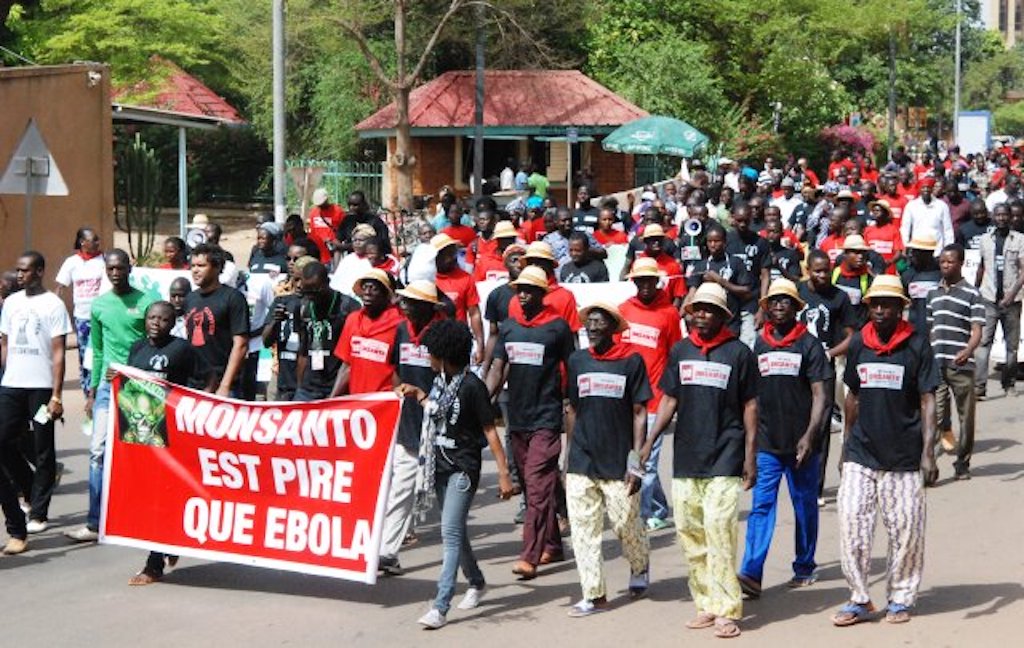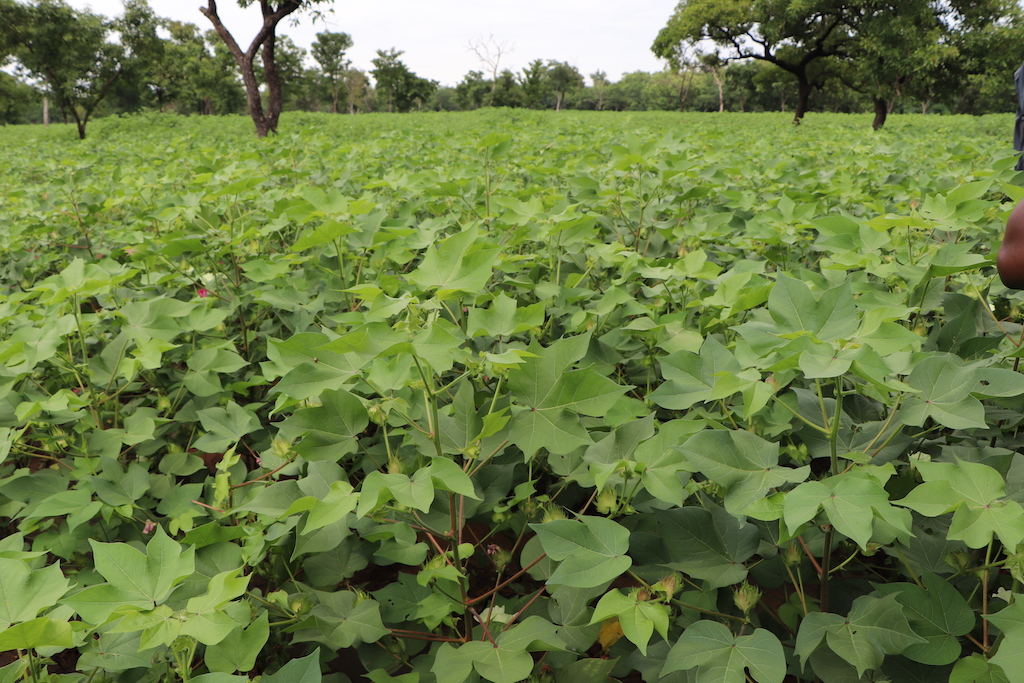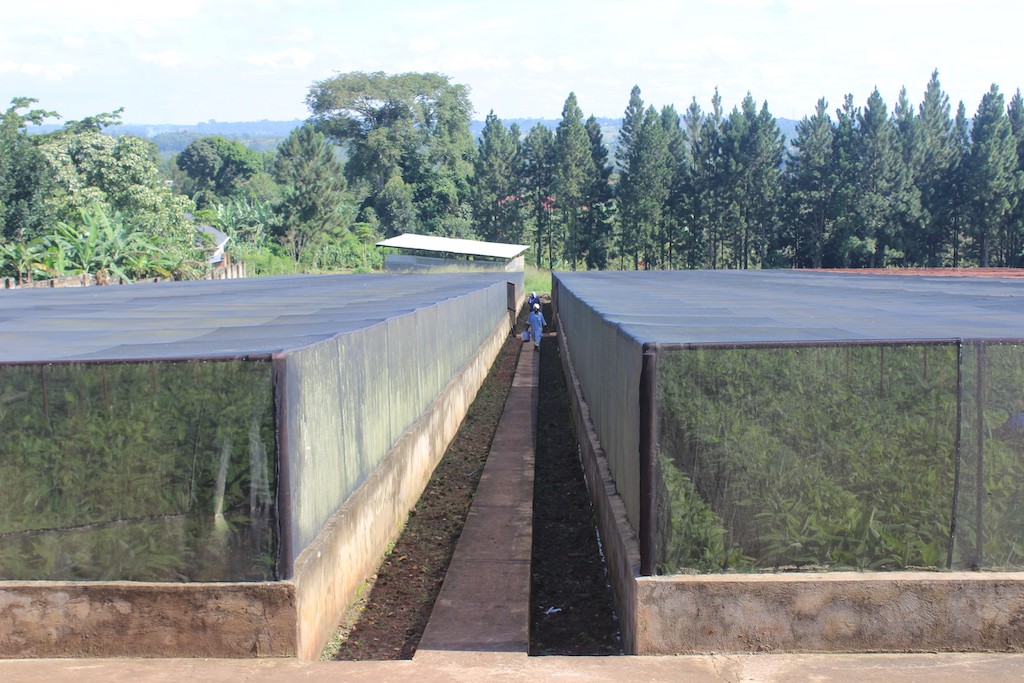
20 Sep Fears of deadly consequences cloud Africa’s attempts to embrace GMOs
In the second of a three-part cross-national investigation into Africa’s GMO industry, Andiswa Matikinca, Arnaud Ouedraogo and Benon Herbert Oluka look into some of the concerns surrounding agricultural biotechnologies, better known as genetically modified organisms (GMOs)

In 2015 protests were organised in Burkina Faso to say ‘no’ to Monsanto and GM cotton. Photo © Burkina 24
When advocates of genetically modified (GM) crops were courting farmers in Burkina Faso, their pitch constituted a bounty of promises. The farmers, they said, would benefit from an increase in their yields, better protection of their crops against pests, greater food security and, most importantly, a general improvement in the livelihoods of people in one of the world’s poorest countries.
The farmers, urged on by their government, embraced Bt cotton – a variety modified to improve pest resistance – developed through a partnership between Burkina Faso and the American food company Monsanto (now Bayer Crop Science). Between 2008 and 2016, up to 150,000 Burkinabe households were farming Monsanto’s cotton gene.
“Burkina Faso had decided to show the way forward as a leader in cotton production in Africa,” recalls a former regional director of agriculture.
The West African country went full throttle in its effort to promote the “new cotton”. According to The Conversation, the supporters of what authorities viewed as an agricultural revolution quickly released the results of a study demonstrating increased yields and incomes as a result of GM cotton cultivation.
However, the model of success sold to the farmers never came to pass. A production disenchantment set in that farmers like Abdramane Traoré, a cotton cultivator, are still reeling from.
“We were duped,” complained Traoré in an interview. “The [cotton] fibres of the GM cotton were shorter and the ginning machines extracted proportionately less fibres from the harvested cotton balls.”
Many of the farmers suffered heavy losses, according to the regional director of a farmers’ group in the Hauts-Bassins region in the west of the country. “It caused losses of more than $40-billion CFA (about $76-million) to the cotton companies, mainly SOFITEX [the state-owned company for fibres and textiles],” he said.
By 2016 both the farmers and the authorities in Burkina Faso were in agreement that they had a raw deal on their hands, so they ditched it.
It was only much later, according to The Conversation and independent inquiries by one member of our team, that Burkina Faso learnt there had been a problem with the results that had initially been used to prop up Bt cotton as a success story.
For instance, as The Conversation’s article notes, the report contained problems with documentation of the study findings, as it did not provide sufficient evidence on how the data was collected.

Organic cotton – symbol of the renewal of the sector in Burkina Faso – in gestation in the fields of Kourouma, west of Burkina, on August 20 2021. Photo © Arnaud Ouedraogo
Conflict of interest
Then conflict of interest also surfaced. Monsanto is said to have funded the evaluation studies under a contract with the Burkinabé Institute for the Environment and Agricultural Research, which raises questions about the independence of the study that projected a generally positive story while farmers were complaining of poor cotton fibre concerns.
The evaluation studies presented additional problems, in particular with regard to the differential impacts of GM cotton, confides a former official of a farmers’ organisation in Burkina.
In the past, studies by the National Center for Scientific and Technological Research (CNRST) had explained how local dynamics can determine the extent to which a farmer benefits from cotton production. However, this was not done or included in the evaluation studies that had built the story of the success of GM cotton.
With Burkina Faso’s GM cotton deal, explains Traoré, the poorest farmers also faced additional difficulties: they used less fertiliser, which worsened the yield problems of GM cotton, and they often had to pay for replacement seeds in cases where their first planting did not germinate. But this did not come out in studies funded by Monsanto.
A contract between Monsanto and its Burkinabe partners also gave the US company 28% of the “added value” of GM cotton, with the rest to farmers and cotton companies. Some sources even believe that the company earned more, because it was paid according to the number of hectares of GM cotton planted.
The head of Uganda’s National Banana Research Programme, Priver Namanya Bwesigye, whose team has developed hybrid varieties of bananas that are resistant to drought and disease, says a major mistake that Burkina Faso made was to deal with a private company whose primary motive is profit.
“The scenario of Burkina Faso was interesting because they had to go to a company to get the seeding, but their lint wasn’t as long as the local variety. So, they had to go back and start introducing it into their local variety, but the marriage didn’t end well,” explained Bwesigye. “In Uganda, we would not have such a case. We don’t work with private companies. We work with national institutions [around the world].”

A facility at AGT Laboratories in Uganda where plant tissue culture takes place. Photo © David Rupiny
Counting the cost
Uganda still has its own challenges to circumvent before it can begin to use biotech products. Without a law, the only recourse for those interested in developing biotech products in the East African country has been the National Biotechnology and Biosafety Policy, which the government passed in 2008. The policy allows scientists to create biotech products and carry out confined trials within approved laboratories. However, they cannot sell their output to the public.
Using the window that the policy offers, Ugandan scientists have made considerable strides. Today, there are genetically modified versions of maize, bananas, cassava, cotton, potatoes, soya beans and other crops, which have several advantages over the indigenous plants.
Some of the benefits from the enhanced crops include improved yields and greater nutritional value, more nutritious varieties, better tolerance to poor environmental conditions, pests and diseases, and the need for less agricultural inputs.
At the National Agricultural Research Laboratories in Kawanda, a town located some 12km outside Uganda’s capital Kampala, Bwesigye’s team has made considerable strides with its hybrid banana variety, never mind the fact that the public cannot yet consume them due to the absence of an enabling law.
Bwesigye is eager to see that the public enjoys the fruits of their research. However, with no end in sight yet for the proposed law, she says the National Agricultural Research Organisation scientists continue to work in anticipation that the two arms of government responsible for the law will eventually start to read from the same script.
For now, though, according to Bwesigye, many of the brains behind Uganda’s genetically engineered crop varieties feel hamstrung by the faltering efforts to establish a long-awaited law.
“Sometimes we feel frustrated,” she says,”but I want to believe that everything has its time. When the policymakers are ready, they will give us the go-ahead because the need for biotechnology products is there; it has not gone away. My job is to produce the products and make them ready [for use by the Ugandan public].”
According to Bwesigye, one crucial issue that she believes Ugandan authorities should focus their energies on is putting in place controls around the trade in GMOs, especially those where Uganda has a competitive advantage over more advanced countries.
“There are crops like maize and soybean, which are grown more by Europeans and Americans. We can’t compete with them because they have genetically modified varieties that grow faster, better, and maybe have added value like the oil they can extract. So, we have to be careful that we should have a law in place that says, ‘If there is any genetically modified soybean that should be done, it has to be developed by Ugandans. If others have it, let the Ugandans learn the technology and come and do it here,” she explained.
The draft law does not have any guidelines on ring-fencing the production of any GMOs to Ugandans. Instead, all the draft law puts in place is a need for any person who seeks to do research, general release, or export, import, or transit a GMO to secure the requisite approvals from the responsible Ugandan authorities. The hope is that Ugandan oversight agencies will be robust enough to weed out scrupulous actors, especially those who may not have a stake in the country’s well being.

Herbicides and pesticides used by farmers been have been linked to non-Hodgkin’s lymphoma, a type of cancer that starts in the white blood cells. Photo Ⓒ Simphiwe Mashexa
Fears of cancer
Bwesigye also believes that because Ugandan scientists are at the centre of the GM crops research and development process, it will inspire Ugandans to embrace them.
“These genetically modified bananas have been developed by us here. We have not imported any genetically modified bananas,” she said in an April 20 interview at her office, a stone throw away from the laboratories where days and nights of their work came to fruition. “When these bananas go out [once the law is in place], I will be the first one to plant them, and I will eat them in my house because I have developed them, and I understand the science.”
However, this is unlikely to completely wade off the GM sceptics, as has happened in South Africa, where health and environmental concerns continue to linger even after a quarter a century of producing GM crops in Africa’s second-richest economy.
Linzi Lewis, a researcher for the African Centre for Biodiversity, says although the centre doesn’t make claims of specific health impacts, there are multiple studies that have been done on potential impacts that link GMOs to non-Hodgkin’s lymphoma as well as different cancers that can be directly related to them.
Non-Hodgkin’s lymphoma is a type of cancer that starts in the white blood cells which are part of the body’s immune system. This cancer has been mentioned in multiple reports and is said to be caused by herbicides.
A 2015 report by the International Agency for Research on Cancer also concluded that glyphosate definitely has the potential to cause cancer in animals studied in laboratories and that human exposure to glyphosate is linked to a higher risk of developing blood cancers such as non-Hodgkin’s lymphoma.
In 2012 French molecular biologist and activist on GMOs and foods, Gilles-Éric Séralini, published a peer-reviewed research paper on a two-year study that showed there was a varied correlation between cancer found especially in female rats tested in labs and GM corn as well as the herbicide RoundUp, which was originally developed by Monsanto. The study was, however, redacted due to its design which was said to be flawed and its findings unsubstantiated.
Lewis says the lack of sufficient studies conducted around the health impacts of GMOs makes it difficult to point out hard evidence.
“There are currently no local bodies that are specifically looking at GMO safety measures on health and this is one of the reasons why it is difficult to get hard evidence around health impacts and there are also no long term studies,” she said.

Maize is one of the three major GM crops cultivated in South Africa. It is also a staple food in many African households. Photo Ⓒ Simphiwe Mashexa
Safety nets
Uganda’s President Yoweri Museveni is one of the sceptics. In a letter to the East African country’s Parliament, he voiced his fear about the use of substances during the production of GM crops that could be cancerous. Museveni wants Uganda’s proposed law to provide a number of safety nets against risks associated with the use of such substances.
“I have been made aware of the fact that genetic engineering involves the use of certain dangerous viruses and bacteria, as well as the use of chemicals like glyphosate, that have been suspected of causing or contributing to the development of cancer,” he noted. “This law should put in place safeguards to protect our soils from such contaminants. Specifically, we should prohibit the use of substances like glyphosate until we have developed our own scientific data showing that it is safe to use on our fertile Ugandan soils.”
Museveni is also against the mixing of GM material with non-GM seeds and material that is indigenous to Uganda. In his July 22 2019 letter, he wrote, “The law must clearly spell out the isolation measures such as greenhouses and isolation distances that will be applicable for any person involved in GM research and production. The law must also address the penalties that apply to any person who fails to apply these measures and allows the co-mingling of GMO with non-GMO material.”
The Vice-Chairman of the Parliamentary Committee on Science and Technology in the 10th Parliament, Bwino Fred Kyakulaga, conceded in a March 9 interview that the legislative body did not address all of Museveni’s concerns the first time he returned the Bill because he was not specific on some of the provisions he wanted the legislators to review.
“Those areas he did not agree with can be categorised into two. There are those where he pointed out specific clauses and his disagreements with those clauses. Then there were areas he disagreed with, but he did not tag them with specific clauses in the Bill. He just spoke about them generally. When we considered the returned Bill, the plenary decided to only look into those areas he specifically pointed out. So, when the Bill was sent in that form to the president, he again returned it and said we should also consider those areas he had not tagged to clauses initially. That’s where we are now,” said Kyakulaga, who is a microbiologist.
Museveni’s reluctance to sign the Bill into law when placed at his table twice has thrown a spanner in the works of the protracted process to institute a law whose first reading before legislators of Uganda’s 9th Parliament happened on February 5 2013.
When the proposed law eventually makes it to Uganda’s Parliament, all eyes will be on the country’s legislative body to see if they will revisit the law to mitigate the challenges that South Africa and Burkina Faso have faced. Whatever Uganda does will offer yet another template for any other African country that wants to introduce GM crops into their economies.
This article forms part of a three-part investigation developed with the support of the Money Trail Project
Read Part 1: Inside 25 years of GMOs in Africa here
